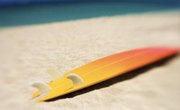
Modern toboggans are made of many materials ranging from plastic to aluminum, but the classic material for making one of these sleds that originated with the native peoples of Canada is wood, typically larch or birch. A traditional treatment to keep the bottom slick was to cover it with pine tar, but wax is most often used today.
Why Treat Your Toboggan
Treating the bottom of your toboggan to a wax coat will make it go faster. A thin layer of water forms from the snow beneath your toboggan as you speed down the slope or drag a load across the frozen landscape. Waxing creates a barrier between this water and the wood so you'll slide over the ground faster.
Putting on the Wax
Before you begin, replace any frayed ropes and tighten up any loose screws and fasteners. Bring your toboggan inside to warm it up and clean and dry the surface for waxing. Remove any old wax buildup with a plastic ice scraper. If you use liquid wax, cover the toboggan's bottom, wait 10 minutes and then buff the wax with a soft nylon brush. With solid wax, apply and then burnish it with a ski cork or use a hair dryer to help melt it. Cover the surface evenly and fill any imperfections. Preserve the top of your wooden toboggan with furniture oil. Always wipe moisture off the toboggan when you're done using it and store it inside in a dry spot. Laying it flat will help preserve its shape for the future.
References
Writer Bio
Joe Steel is a Northwest-based editor, writer and novelist, former news editor of an outdoor weekly. He also was an editor at a Seattle-based political weekly and editor of a monthly business magazine. He has been published in the "Seattle Times," the "Washington Post" and the "Foreign Service Journal," among other publications.



